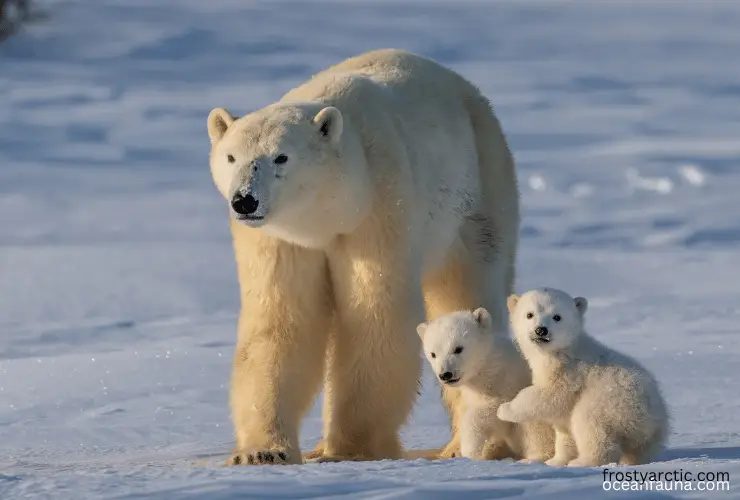Yes, polar bears inhabit many regions across Alaska, including Kaktovik, the Alaska Zoo, St. Lawrence Island, and St. Mathew Island. Since polar bears live in the Arctic, Alaska is the only northern state in the USA where these creatures can thrive. A population of 4000 to 7000 polar bears inhabits Alaska.
Polar bears are found in the Arctic Circle near the ocean, traveling across massive ice fields. The gigantic Arctic creatures are scattered across northern Canada, Greenland, Russia, Norway, and Svalbard. This article explores the polar bear habitat in Alaska. So, let’s get started!
How Many Polar Bears Are in Alaska?
Researchers believe that Alaska is the only region in the United States where polar bears can survive. According to the National Park Service, an estimated population of between 4000 and 7000 polar bears thrives in Alaska.
In the northern states, only two park units have reported polar bears living nearby, with a home range reaching into park boundaries. These parks include Bering Land Bridge National Preserve and Cape Krusenstern National Monument.
What Do Polar Bears in Alaska Look Like?

Polar bears are giant creatures closely linked with brown bears. Their average height is up to 2.4 meters (7.8 feet) on their hind legs, while they can weigh up to 600 kg (1,300 pounds).
The bears are covered in thick, transparent fur layers, preventing heat loss. Ostensibly, polar bear fur appears white, but in reality, it is transparent hair that scatters and reflects visible light.
Beneath their fur layer, polar bears have a fat layer up to 11.4 cm (4.49 in) thick. The fat layer insulates them underwater, while the fur keeps them warm when their bodies are dry.
Polar bear paws measure up to 30 cm (11.81 in), allowing them to distribute their weight evenly when standing upright.
Which Country Has the Most Polar Bears?
According to the World Wild Life Fund, Canada has the largest population of polar bears. About 60% of the world’s polar bears inhabit Canada most of the year.
The world’s southernmost polar bears are found in Southern Hudson Bay, Manitoba, Ontario, and Quebec, Canada. Churchill, Manitoba, is known as the “polar bear capital,” with nearly 900 polar bears.
Mostly, polar bears tend to inhabit northern Canada, making them a primary part of the northern culture. However, the sea ice loss is forcing them to move ashore, risking human lives. ~ WWF CA
What Are The Best Places to See Polar Bears in Alaska?

01. Kaktovik
Kaktovik is an Eskimo village, a popular destination for viewing polar bears. Many companies conduct tours of this Eskimo village via flights. Thus, tourists can get spectacular views of Alaska’s Arctic village, home to many polar bears.
Kaktovik is just 2250 kilometers from the North Pole on Barter Island. The “Bone Pile,” a popular touring spot in the village, is the habitat of polar bears.
02. Bering Land Bridge Preserve
The Bering Land Bridge Preserve is the most remote protected area and home to many polar bears. The preserved landscape boasts prehistoric sites of early human civilization.
Polar bears roam the Arctic ice sheets and swim in that region’s coastal waters, so carrying the necessary gear to survive the harsh weather conditions is important if you aim to observe them. Even during the summer, the weather can be icy.
03. Cape Krusenstern National Monument
Several marine mammals inhabit the Cape Krusenstern National Monument, including polar bears.
Sometimes, you might not spot polar bears, but taking the necessary precautions is always best because you never know if a bear is heading towards you from lands away from the ice sea.
04. St Lawrence Island
St. Lawrence Island is located in the Bering Sea, west of Alaska. Polar bear sightings in this region are quite common, especially in the winter.
In August and October, the ocean ice melts, and polar bears venture toward the land. This is the best time of the year to spot a polar bear making its way toward the land.
05. St Mathew Island
St Mathew Island is located South of St Lawrence Island, a popular destination for polar bear sightings, but only at the right time and under the right conditions.
Polar bear sightings are most common in August and October, when the climate is ideal for the bears to visit the land.
06. Alaska Zoo
The Alaska Zoo houses one female polar bear named Cranberry. Visitors can observe the magical creature through a safety glass, but it is not as exciting as seeing polar bears in their natural habitat.
Can Polar Bears be Spotted in Alaska in the Summer?
You can spot polar bears on Alaska’s northern and north-western coasts all year round. However, summer is ideal for polar bear sightings because the sea ice splits and drifts away from the shoreline.
The sea ice is where you can find polar bears spending the majority of their time (between August and October). You will find them in a group on the coast near Barter Island in Kaktovik, Alaska.
Did you know? In spring, polar bears stay on the sea ice because of greater accessibility to food, including seals. Pregnant female bears venture out to barrier islands at this time of the year.
Are Polar Bears in Alaska Dangerous?

Although polar bear attacks in Alaska are uncommon, Arctic animals can be very dangerous.
The majestic white bears live far away from human communities. However, attacks are possible because polar bears are not used to human activity, unlike other bear species.
Between 2010 and 2014, there were 15 attacks, a significant increase from the average of 7-12 attacks every ten years. ~ The Wildlife Society
Because the Alaskan population is accustomed to the aggressive nature of polar bears, they avoid actively seeking out these massive animals. Plus, polar bears are not as afraid of humans as other bears.
As the Arctic ice melts, polar bears move southward, increasing their chances of contact with humans and posing a threat to humans and marine animals.
Polar bears can be considered dangerous because of their massive size. The bears weigh up to 1,300 pounds and have an average height of 7.8 feet when standing on their hind legs, making it much harder to survive a polar bear attack.
Although they are gigantic animals, they can run at surprising speeds of up to 25 mph. Plus, polar bear bites can be fatal, making them dangerous creatures.
Are Their Polar Bears in Antarctica?
No, there are no polar bears in Antarctica, even though the climate and food sources in the region are abundant for their survival.
Polar bears are excellent swimmers but could not migrate to Antarctica, the continent separated from other continents by the Southern Ocean. Plus, if polar bears were to live in Antarctica, they would destroy the native animals, including penguins. ~ Aurora Expeditions, Australia
Polar bears are moving southward due to the melting ice in the Arctic. However, they haven’t moved as far south as Antarctica or any sub-Antarctic islands.
Frequently Asked Questions (FAQs):
What bears live in Alaska?
Alaska is home to three kinds of bears: black, brown, grizzly, and polar bears.
What do polar bears eat in Alaska?
Polar bears rely on meat because of a lack of vegetation in the Arctic. Their diet includes seals, small rodents, fish, and animal carcasses (such as whales, walruses, and seals).
What are polar bear predators?
Polar bears do not have any natural predators. However, cubs often fall prey to wolves and other carnivores.
Conclusion:
Although the largest polar bears live in Canada, Alaska is the only state in the United States where polar bears can survive, thanks to its ideal climate and abundance of food.
Polar bear sightings are common in state regions, such as Kaktovik, the Alaska Zoo, St. Lawrence Island, and St. Mathew Island.



4 thoughts on “Are There Polar Bears in Alaska?”